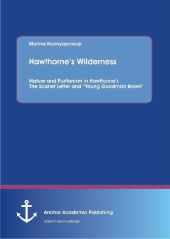 Neuerscheinungen 2013Stand: 2020-01-07 |
Schnellsuche
ISBN/Stichwort/Autor
|
Herderstraße 10
10625 Berlin
Tel.: 030 315 714 16
Fax 030 315 714 14
info@buchspektrum.de |

Marina Boonyaprasop
Hawthorne´s Wilderness
Nature and Puritanism in Hawthorne´s The Scarlet Letter and Young Goodman Brown
2013. 116 p. 220 mm
Verlag/Jahr: ANCHOR ACADEMIC PUBLISHING 2013
ISBN: 3-9548904-4-5 (3954890445)
Neue ISBN: 978-3-9548904-4-6 (9783954890446)
Preis und Lieferzeit: Bitte klicken
Nathaniel Hawthorne is one of America s most noted and highly praised writers, and a key figure in US literature. Although, he struggled to become an acknowledged author for most parts of his life, his work stands in the limelight of the American literary consciousness (Graham 5).
For he is a direct descendant of Massachusetts Bay colonists in the Puritan era of the 17th and 18th century, New England served as a lifelong preoccupation for Hawthorne, and inspired many of his best-known stories. Hence, in order to understand the author and his work, it is crucial to apprehend the historical background from which his stories arose. The awareness of the Puritan legacy in Hawthorne s time, and their Calvinist beliefs which contributed to the establishment of American identity, serve as a basis for fathoming the intention behind Hawthorne s writings. His forefathers concept of wilderness became an important part of their religious life, and in many of Hawthorne s tales, nature can be perceived as an active agent for the plot and the moral message. Therefore, it is indispensable to consider the development behind the Puritan perception, as well as the prevailing opinion on nature during the writer s lifetime.
After the historical background has been depicted, the author himself is focused. His ambiguous character and non-persistent lifestyle are the source of many themes which can be retrieved from his works. Thus, understanding the man behind the stories is necessary in order to analyze the tales themselves. Seclusion, nature, and Puritanism are constantly recurring topics in the author s life and work. To become familiar with Hawthorne s relation to nature, his ancestors, and religion, it is essential to understand the vast amount of symbols his stories.
His stories will be brought into focus, and will be analyzed on the basis of the historical and biographical facts, and further, his particular style and purpose will be taken into consideration.The second part of this book analyzes two of the author s most eminent and esteemed works, namely Young Goodman Brown and The Scarlet Letter in terms of nature symbolism and the underlying moral intention. Further, it is examined to which extent the images correspond to the formerly explained historical facts, and Hawthorne s emphasized characteristic features.
The comparison of the two works focuses on the didactic purpose for in all of his works, Hawthorne s aim was to give a lesson. Thus, it will provide an in-depth understanding of the author s intentions and his utilization of Puritanism and nature perception.


